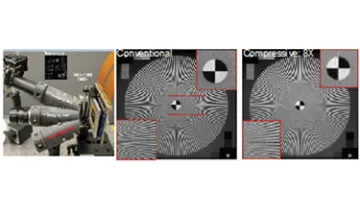Date Published: November 24, 2014
As imaging devices — from smartphones to military drones to security cameras to cars — become ubiquitous, rising data volume and processing demands become problematic. Compression is routinely employed to reduce image file sizes for convenient storage and transmission. However, the success of image compression techniques suggests that traditional imaging systems can be highly inefficient, collecting redundant data that could be compressed without significant degradation. The field of compressive imaging addresses this shortcoming by acquiring a “compressed image” directly in the optical domain.

Left: Compressive imager prototype. Right: Images from traditional imager and prototype at eight times compression.
One direct benefit of such optical compression is that it employs energy-efficient low-resolution sensors, rather than the power-hungry high-resolution image sensors typically found in traditional high-quality cameras (e.g., digital single-lens reflex cameras). The prototype shown above, developed by Amit Ashok’s Intelligent Imaging and Sensing Laboratory under U.S. Army and Defense Advanced Research Projects Agency programs, is capable of forming high-resolution images using a low-resolution sensor and a programmable spatial light modulator. Compressive imaging has the potential to make significant impacts in spectral bands (e.g., infrared, terahertz), where sensor costs and complexity dominate camera design.
